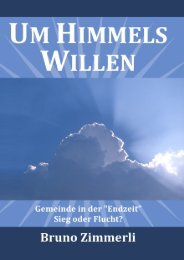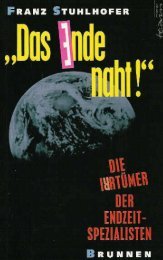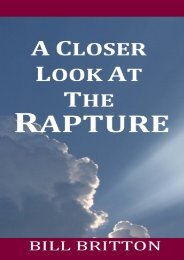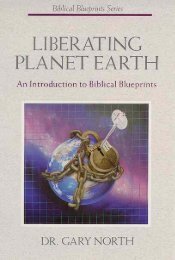- Page 2 and 3:
HE SHALL HAVE DOMINION A P o s t m
- Page 4:
Dedicated to the memory of two serv
- Page 7 and 8:
PART SIX: CONCLUSION 20. Concluding
- Page 9 and 10:
Chapter 6: The Covenants of Redempt
- Page 11 and 12:
The Exhortations in John’s Conclu
- Page 14 and 15:
ABBREVIATIONS Biblical Note: In the
- Page 16 and 17:
Abbreviations CT Christianity Today
- Page 18 and 19:
Abbreviations K-D Keil, C. F. and F
- Page 20 and 21:
Abbreviations PSB Prophecy Study Bi
- Page 23 and 24:
“Christ Shall Have Dominion” Fr
- Page 26 and 27:
PREFACE Third Edition By the grace
- Page 28 and 29:
Preface xxix target for those who a
- Page 30 and 31:
Preface xxxi the “consistent pret
- Page 32 and 33:
Preface xxxiii But these are also t
- Page 34:
PART I INTRODUCTION
- Page 37 and 38:
2 He Shall Have Dominion victory, c
- Page 39 and 40:
4 He Shall Have Dominion from anoth
- Page 41 and 42:
6 He Shall Have Dominion The Englis
- Page 43 and 44:
8 He Shall Have Dominion 13 questio
- Page 45 and 46:
10 He Shall Have Dominion 20 remain
- Page 47 and 48:
12 He Shall Have Dominion Willem Va
- Page 49 and 50:
14 He Shall Have Dominion the last
- Page 51 and 52:
16 He Shall Have Dominion theology
- Page 53 and 54:
18 He Shall Have Dominion 44 influe
- Page 55 and 56:
20 He Shall Have Dominion Augustine
- Page 57 and 58:
22 He Shall Have Dominion 58 hence,
- Page 59 and 60:
24 He Shall Have Dominion public ba
- Page 61 and 62:
26 He Shall Have Dominion which app
- Page 63 and 64:
28 He Shall Have Dominion 75 Ex 20:
- Page 65 and 66:
30 He Shall Have Dominion Such an h
- Page 67 and 68:
32 He Shall Have Dominion fortuity
- Page 69 and 70:
34 He Shall Have Dominion The Separ
- Page 71 and 72:
36 He Shall Have Dominion Timothy P
- Page 73 and 74:
38 He Shall Have Dominion of histor
- Page 75 and 76:
40 He Shall Have Dominion see no br
- Page 77 and 78:
42 He Shall Have Dominion 122 be li
- Page 79 and 80:
44 He Shall Have Dominion 132 premi
- Page 81 and 82:
46 He Shall Have Dominion Among ami
- Page 83 and 84:
48 He Shall Have Dominion Willem Va
- Page 85 and 86:
50 He Shall Have Dominion Hendrikus
- Page 87 and 88:
52 He Shall Have Dominion Because o
- Page 89 and 90:
54 He Shall Have Dominion 171 throu
- Page 91 and 92:
56 He Shall Have Dominion apostasy,
- Page 93 and 94:
58 He Shall Have Dominion provides
- Page 95 and 96:
60 He Shall Have Dominion Unfortuna
- Page 97 and 98:
62 He Shall Have Dominion This prob
- Page 99 and 100:
64 He Shall Have Dominion 15 ignora
- Page 101 and 102:
66 He Shall Have Dominion Many evan
- Page 103 and 104:
68 He Shall Have Dominion sented fo
- Page 105 and 106:
70 He Shall Have Dominion 37 makes
- Page 107 and 108:
72 He Shall Have Dominion republish
- Page 109 and 110:
74 He Shall Have Dominion successfu
- Page 111 and 112:
76 He Shall Have Dominion premillen
- Page 113 and 114:
78 He Shall Have Dominion matter: D
- Page 115 and 116:
80 He Shall Have Dominion 72 those
- Page 117 and 118:
82 He Shall Have Dominion make thei
- Page 119 and 120:
84 He Shall Have Dominion multivale
- Page 121 and 122:
86 He Shall Have Dominion add Progr
- Page 123 and 124:
88 He Shall Have Dominion you under
- Page 125 and 126:
90 He Shall Have Dominion be true t
- Page 127:
92 He Shall Have Dominion intensely
- Page 130 and 131:
Ch. 3: The Pessimistic Millennial V
- Page 132 and 133:
Ch. 3: The Pessimistic Millennial V
- Page 134 and 135:
Ch. 3: The Pessimistic Millennial V
- Page 136 and 137:
Ch. 3: The Pessimistic Millennial V
- Page 138 and 139:
Ch. 3: The Pessimistic Millennial V
- Page 140 and 141:
Ch. 3: The Pessimistic Millennial V
- Page 142 and 143:
Ch. 3: The Pessimistic Millennial V
- Page 144 and 145:
Representative Adherents In the anc
- Page 146 and 147:
47 “progressive dispensationalism
- Page 148 and 149:
9. Christ will call down fire from
- Page 150 and 151:
earth and reign with Christ. Of the
- Page 152 and 153:
7. God will intervene with fiery ju
- Page 154 and 155:
4 THE POSTMILLENNIAL SYSTEM The LOR
- Page 156 and 157:
Christ’s Spirit-filled people. Th
- Page 158 and 159:
y Louis Berkhof, Philip Schaff, Alb
- Page 160 and 161:
Clearly, the ancient advocates of p
- Page 162 and 163:
41 Whitby (AD 1638-1726), a Unitari
- Page 164 and 165:
“unrealistic expectation that Chr
- Page 166 and 167:
only one in that age of violent per
- Page 168 and 169:
promulgate, over the minds of men;
- Page 170 and 171:
the unbelievers can do none of thes
- Page 172 and 173:
nation, neither shall they learn wa
- Page 174 and 175:
nations for Thine inheritance,’ w
- Page 176 and 177:
lennialism. We discover such postmi
- Page 178 and 179:
Richard Sibbes (1577-1635) John Guy
- Page 180 and 181:
Reformed premillennialist J. Barton
- Page 182:
Conclusion Systematization of the v
- Page 186 and 187:
5 THE REVELATION OF TRUTH “So sha
- Page 188 and 189:
11 apostles insist that men accept
- Page 190 and 191:
The Providential Word God’s word
- Page 192 and 193:
Since we are fallen, temporal, and
- Page 194:
and justice” (Ps 33:4-5a). God’
- Page 197 and 198:
for faithful adherence to those ter
- Page 199 and 200:
I will deal with the significance o
- Page 201 and 202:
etween priests and ordinary men, bu
- Page 203 and 204:
In the new covenant era itself we d
- Page 205 and 206:
not stages in the revelation of the
- Page 207 and 208:
They were learning corporate respon
- Page 209 and 210:
Furthermore, eventually all men wil
- Page 212 and 213:
7 THE HERMENEUTIC OF SCRIPTURE Know
- Page 214 and 215:
Since Ryrie is perhaps the most pro
- Page 216 and 217:
Can anyone accept such views of Jer
- Page 218 and 219:
Feinberg agrees: “Every prophecy
- Page 220 and 221:
41 12:28; Lk 17:20-21). These proph
- Page 222 and 223:
This is the standard exposition of
- Page 224 and 225:
This argument is not at all persuas
- Page 226 and 227:
day.” Though it diminishes the fi
- Page 228 and 229:
Christian exegete must allow the Ne
- Page 230 and 231:
95 of a geographic and ethnic liter
- Page 232 and 233:
107 come.” Ancient rabbinic Judai
- Page 234 and 235:
Chung states: “For Jesus, then,
- Page 236 and 237:
Preterism has a secure foundation i
- Page 238 and 239:
As with any system developed by fal
- Page 240 and 241:
(1) The Church is not fulfilling in
- Page 242 and 243:
male nor female; for you are all on
- Page 244 and 245:
148 referring to the new covenant o
- Page 246 and 247:
Then they also will be a remnant fo
- Page 248 and 249:
speaks in such tones that we may no
- Page 250 and 251:
High Priest tries Jesus, even bring
- Page 252:
PART III EXPOSITION
- Page 255 and 256:
are its precursors? How will it be
- Page 257 and 258:
Then he declares that man should co
- Page 259 and 260:
2:16-17), fellowship with (Ge 3:8),
- Page 261 and 262:
over the works of Your hands; You h
- Page 263 and 264:
36 and Satan” (Rev 12:9; 20:2), w
- Page 265 and 266:
over reprobation. Christ’s resurr
- Page 267 and 268:
sovereign grace and redemptive sacr
- Page 269 and 270:
You also multiplied their children
- Page 271 and 272:
the expanding of these Land promise
- Page 273 and 274:
49:8-10 promises that Judah will ma
- Page 275 and 276:
king,” but as “my King.” Vers
- Page 277 and 278:
J. A. Alexander, E. W. Hengstenberg
- Page 279 and 280:
eference to Melchizedek in verse 4,
- Page 281 and 282:
judging between many nations and of
- Page 283 and 284:
and wide, and then preserves and ca
- Page 285 and 286:
crush the world kingdom, which appe
- Page 287:
as comprehensive as sin is, and mor
- Page 290 and 291:
other hand, amillennialism garners
- Page 292 and 293:
John Baptist, Christ’s divinely c
- Page 294 and 295:
14 employed.” Thus, his disciples
- Page 296 and 297:
The Coronation of the King A freque
- Page 298 and 299:
God, and we take captive every thou
- Page 300 and 301:
The Pentecostal Message. The first
- Page 302 and 303:
unbelieving populace. Just as the J
- Page 304 and 305:
41 reject it, thus causing its post
- Page 306 and 307:
accusation against him (Jn 18:34)
- Page 308 and 309:
Israel will be a glorious nation, p
- Page 310 and 311:
Conclusion The New Testament portra
- Page 312 and 313:
saw in chapter 8, “dominion” is
- Page 314 and 315:
nations. They are not simply to pre
- Page 316 and 317:
postmillennial emphasis, whereas th
- Page 318 and 319:
15 commitment” required to enter
- Page 320 and 321:
triumph of the Gospel — that it w
- Page 322 and 323:
• In the imagery of the parables,
- Page 324 and 325:
demands gradual growth: “The king
- Page 326 and 327:
it that the world must be restored
- Page 328 and 329: 46 Israel’s promises by becoming
- Page 330 and 331: But notice what precedes the end. V
- Page 332 and 333: Me” (Mt 28:18). He has both the r
- Page 334 and 335: ism believes that at Christ’s sec
- Page 336 and 337: 66 fact, in John 7:38 Christ presen
- Page 338 and 339: Some suggest, and I tend to agree,
- Page 340 and 341: 88 Christ. We have the very presenc
- Page 342 and 343: 1:7-11). We should be even more con
- Page 344 and 345: disciple all nations. This is preci
- Page 346 and 347: creature: Adam is to “cultivate
- Page 348 and 349: world.” And we must understand th
- Page 350 and 351: men, it will attain at last to a co
- Page 352 and 353: of postmillennial eschatology, I wi
- Page 354 and 355: clouds as symbols of God’s wrath
- Page 356 and 357: taken up from you into heaven, will
- Page 358 and 359: church only, and unseen and unknown
- Page 360 and 361: are: (1) The resurrection of the ri
- Page 362 and 363: 45 and the Augsburg Confession. Of
- Page 364 and 365: and the first “resurrection will
- Page 366 and 367: Third, Scripture knows of only one
- Page 368 and 369: made righteous at the resurrection
- Page 370 and 371: ity for enjoying he blessings of th
- Page 372 and 373: The doctrine of eternal punishment
- Page 374 and 375: Scripture demonstrates (Lk 16:23; R
- Page 376 and 377: concept of rewards points in this d
- Page 380 and 381: Furthermore, this destruction termi
- Page 382: PART IV SPECIFICATION
- Page 385 and 386: 4 about future events related to th
- Page 387 and 388: Chronological Value The seventy wee
- Page 389 and 390: Israel’s sins (Da 9:4ff) and the
- Page 391 and 392: hand. Repent, and believe in the go
- Page 393 and 394: 45 years after the crucifixion, the
- Page 395 and 396: (allegedly) allows for a gap betwee
- Page 397 and 398: Several problems plague this interp
- Page 399 and 400: 60 5:39). Thus, Christ stands as hi
- Page 401 and 402: conflicts that we see in our world
- Page 403 and 404: 80 81 the second coming,” that we
- Page 405 and 406: eturn be imminent in the first cent
- Page 407 and 408: in all of human history. We are abo
- Page 409 and 410: coming and yet that his coming will
- Page 411 and 412: “the key biblical passage for suc
- Page 413 and 414: with a chain, which surely is not l
- Page 416 and 417: 14 ESCHATOLOGICAL FEATURES Now as H
- Page 418 and 419: judgment upon Israel (cf. Dt 28:49;
- Page 420 and 421: evealing themselves in the present,
- Page 422 and 423: generation. Consequently, God’s j
- Page 424 and 425: dismissive complaint: “Jesus spok
- Page 426 and 427: Bloesch agrees: “Part of the prob
- Page 428 and 429:
metaphor explaining the divine prov
- Page 430 and 431:
things the universe stands: upon To
- Page 432 and 433:
Some dispensationalists even hold t
- Page 434 and 435:
Furthermore, Walvoord admits, “th
- Page 436 and 437:
This re-establishes what the New Te
- Page 438 and 439:
temple symbolizes God’s glorious
- Page 440 and 441:
cornerstone (Lk 20:17; 1Co 3:11, 16
- Page 442 and 443:
not be described in any other way.
- Page 444:
sorrow caused by his past displeasu
- Page 447 and 448:
New Testament mentions no other Old
- Page 449 and 450:
actual corporeal return of Elijah f
- Page 451 and 452:
Many writers argue that other figur
- Page 453 and 454:
from our future expectation but fro
- Page 455 and 456:
however, have representatives. This
- Page 457 and 458:
47 dies on June 8, AD 68, forty-two
- Page 459 and 460:
Paul warns of Jewish persecution:
- Page 461 and 462:
60 The evidence proves that the har
- Page 463 and 464:
them, and these are all acting cont
- Page 465 and 466:
70 some believe that the Day of the
- Page 467 and 468:
ministry among them allows it: they
- Page 469 and 470:
lawless one is according to the wor
- Page 471 and 472:
expectation, the preterist approach
- Page 473 and 474:
swiftness — even though it may no
- Page 475 and 476:
“great tribulation” (Rev 7:14)
- Page 477 and 478:
Then John steels his readers agains
- Page 479 and 480:
As the Lamb opens the seals, the ju
- Page 481 and 482:
29 hold back the “winds” (of de
- Page 483 and 484:
holy house burned down, and by the
- Page 485 and 486:
ises from the sea, which suggests t
- Page 487 and 488:
the city,” i.e., outside Jerusale
- Page 489 and 490:
56 Germany. The beast fails to dest
- Page 491 and 492:
Christ’s ministry upon earth unti
- Page 493 and 494:
Father has life in Himself, so He h
- Page 495 and 496:
(1) The time frame, following close
- Page 498:
PART V OBJECTION
- Page 501 and 502:
Herman Hoyt complains: “I am unab
- Page 503 and 504:
13 These and other writers would do
- Page 505 and 506:
moans the decline of Christianity,
- Page 507 and 508:
scholarly articles and technical bo
- Page 509 and 510:
Destiny; The Rapture Book: Victory
- Page 511 and 512:
48 God.” As Morton Smith observes
- Page 513 and 514:
seemed to him like a ‘few days’
- Page 515 and 516:
agrees: “The Bible clearly teache
- Page 517 and 518:
ism’s standard is the written rev
- Page 519 and 520:
accept any doctrine which could be
- Page 521 and 522:
Ryrie charges that the “social go
- Page 523 and 524:
asis of hope. Though many of the ho
- Page 525 and 526:
Our defense But is the preterist sc
- Page 527 and 528:
The Gospel of Matthew. Some scholar
- Page 529 and 530:
Rosemary Ruether, Faith and Fratric
- Page 531 and 532:
Commenting on Hab 2:8 they wrote:
- Page 534 and 535:
18 THEOLOGICAL OBJECTIONS So he ans
- Page 536 and 537:
Here the answer is: No. In both cas
- Page 538 and 539:
13 is genuine cause for concern.”
- Page 540 and 541:
21 in the rich blessings that flow
- Page 542 and 543:
Venema continues this line of criti
- Page 544 and 545:
ings “age to come” principles i
- Page 546 and 547:
ascended) Jesus embodies a power/vi
- Page 548 and 549:
elsewhere in the New Testament (e.g
- Page 550 and 551:
church’s existence” of which no
- Page 552 and 553:
deepest longings as sons of God (cf
- Page 554 and 555:
of argument. They forget the postmi
- Page 556 and 557:
19 BIBLICAL OBJECTIONS These were m
- Page 558 and 559:
This entire dispensational scheme i
- Page 560 and 561:
In the latter part of verse 5 the c
- Page 562 and 563:
Obviously, for the evangelical Chri
- Page 564 and 565:
never gain the upper hand in the wo
- Page 566 and 567:
Dispensationalists employ this vers
- Page 568 and 569:
will avenge them speedily” (Lk 18
- Page 570 and 571:
45 compromising the eschatological
- Page 572 and 573:
duration, and that He will not retu
- Page 574 and 575:
fire, and smoke” coming upon Jeru
- Page 576 and 577:
incarnation (Ac 3:18); Christ is Go
- Page 578 and 579:
2 Timothy 3:1-4, 13 But realize thi
- Page 580 and 581:
personal degeneration, i.e., the pr
- Page 582 and 583:
Indeed, all postmillennialists woul
- Page 584 and 585:
The postmill looks for a fulfillmen
- Page 586 and 587:
Riddlebarger stumbles badly later w
- Page 588:
(ta ethne) is a common phrase that
- Page 592 and 593:
20 CONCLUDING REMARKS Declaring the
- Page 594 and 595:
exercising God’s covenant lawsuit
- Page 596 and 597:
prophets (Ps 22:27-28; Isa 2:1-4; M
- Page 598 and 599:
APPENDIX THE HYPER-PRETERIST ERROR
- Page 600 and 601:
appear to be continually mutating,
- Page 602 and 603:
Creedal Failure 12 Brief Theologica
- Page 604 and 605:
Resurrection Errors Fifth, their mo
- Page 606 and 607:
History and Church Errors Eleventh,
- Page 608 and 609:
who have no need of marriage nor di
- Page 610 and 611:
can arise to eschatological glory.
- Page 612 and 613:
know that Adam was not immaterial,
- Page 614 and 615:
Christ himself points out that some
- Page 616 and 617:
As I argue on pages 355-56 above, h
- Page 618 and 619:
order that all things which are wri
- Page 620 and 621:
Vern Crisler, “The Eschatological
- Page 622:
He will redeem their life from oppr
- Page 625 and 626:
Bahnsen, Greg L. and Kenneth L. Gen
- Page 627 and 628:
Blomberg, Craig L. Blomberg and, Su
- Page 629 and 630:
Clark, David S. The Message from Pa
- Page 631 and 632:
Dean, D. A. Dean. Resurrection: His
- Page 633 and 634:
Faulkner, Neil. Apocalypse: The Gre
- Page 635 and 636:
Gentry, Kenneth L., Jr. The Charism
- Page 637 and 638:
Hay, David M. Glory at the Right Ha
- Page 639 and 640:
House, H. Wayne and Thomas D. Ice.
- Page 641 and 642:
Kline, M. G. Treaty of the Great Ki
- Page 643 and 644:
Lindsey, Hal. Planet Earth — 2000
- Page 645 and 646:
Mendenhall, G. E. Law and Covenant
- Page 647 and 648:
North, Gary. Is the World Running D
- Page 649 and 650:
Ramsey, William. The Letters to the
- Page 651 and 652:
Sandlin, Andrew, ed. Creation Accor
- Page 653 and 654:
Swete, Henry B. Commentary on Revel
- Page 655 and 656:
Walvoord, John F. Armageddon, Oil a
- Page 657 and 658:
Alexander, J. A. “The End is Not
- Page 659 and 660:
Gentry, Kenneth L., Jr. “Christ
- Page 661 and 662:
Lindsey, Hal. “The Rise of Babylo
- Page 663 and 664:
Ramsey, A. M. “What was the Ascen
- Page 665 and 666:
White, Fowler. “Agony, Irony, and
- Page 668 and 669:
Genesis 1:1 17, 18, 120 1:5 116 1:1
- Page 670 and 671:
13:10-13 154-55 13:17-22 153 19:1 2
- Page 672 and 673:
12:28 220, 241, 300, 519 12:28-29 5
- Page 674 and 675:
10:35 114 12:15-16 232 12:31 267, 5
- Page 676 and 677:
6:15 168, 367 6:16 82, 168, 520 Eph
- Page 678 and 679:
2 John 7 378 Jude 6 415 Revelation
- Page 680 and 681:
— A — abomination of desolation
- Page 682 and 683:
persecution of, 318, 381, 383, 392,
- Page 684 and 685:
— G — Gabriel, 317, 322 Gaius (
- Page 686 and 687:
Jew/Gentile distinction, 74, 168-69
- Page 688 and 689:
Olivet Discourse, 159-62, 333, 346,
- Page 690 and 691:
Revelation (of John), 162-165, ch.
- Page 692:
216, 359, 399, 401, 406, 493-96, 53
- Page 695 and 696:
Bruce, F. F., 5, 386, 502 — C —
- Page 697 and 698:
Hunt, Dave, 27,48, 56, 157, 237, 28
- Page 699 and 700:
— S — Sanders, E. P., 68 Saucy,
- Page 701:
www.NiceneCouncil.com Books Amazing

















